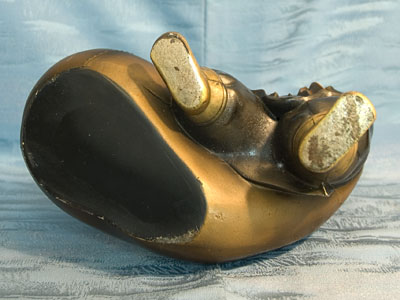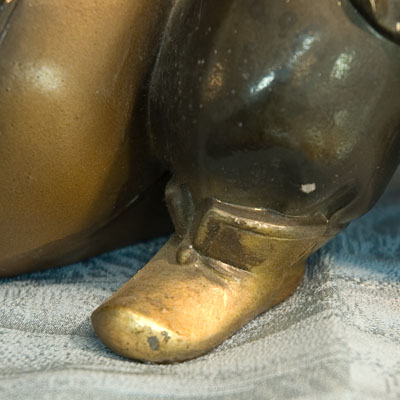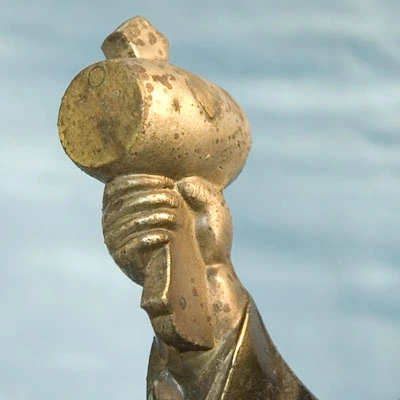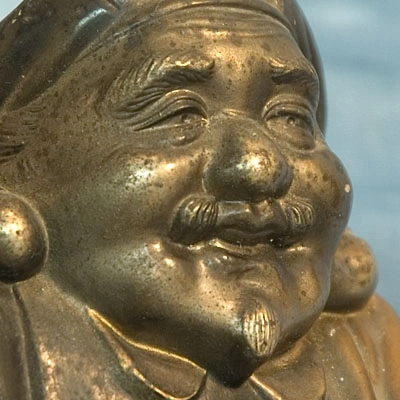












Description
Antique brass image of Daikoku, Japan’s god of wealth and good fortune. Daikoku is one of the most famous and celebrated gods within the Japanese Shinto (native religion of Japan) pantheon (please read below to learn more about Shinto). Daikoku is one of seven popular luck gods collectively known as Shichifukujin. These famous gods (six male and one female) are frequently seen together in Japanese art, often on a boat sailing the seas of fortune. Daikoku is usually depicted holding his wonderful luck hammer which he waves to dispense good fortune upon worthy humans. The god is also frequently shown standing upon two large bales of rice, an auspicious symbol of prosperity. The happy luck god wears one of the most captivating smiles in all Asian art and is nearly always depicted in the act of joyfully visiting wealth and happiness upon the earth (note the bag of goodies carried over his left shoulder).
About the Listed Item
The large, old brass Daikoku display statue (okimono) offered here is in poor to fair condition with marks and scratches from handling. This wonderful old statue dates from the early to mid 20th century and wears a darkened patina of age which we believe enhances the figure’s character and appeal. The Daikoku figure and treasure sack are made of brass while the small child and Daikoku’s hammer are made of a silver-colored metal which we cannot identify.
Size:
Height (from base to top of Daikoku’s hammer): 9.0 inches (23.0 centimeters)
Width (across base): 9.0 inches (23.0 centimeters)
Depth (across base): 5.9 inches (15.0 centimeters)
Weight: 7.0 pounds (3.18 kilograms)
Important Note:
Please be sure to note the shipping cost for this sake large and heavy brass statue. Shipment is via international Express Mail Service (EMS) which included a tracking number and insurance.
Click here to see other Daikoku items!
Click here to see more Shinto items!
Click here to see additional treasures from Japan!
More about the Shinto religion
Shinto is one of the two major religions of Japan (the other is Buddhism). Shinto is often considered to be the native religion of Japan, and is as old as Japan itself. The name Shinto means “the way of the gods.” Shinto is a pantheistic religion, in which many thousands of major and minor gods are thought to exist. The Japanese have built thousands of shrines (jinja) throughout the country to honor and worship these gods. Some shrines are huge and are devoted to important deities. Other shrines are small and may be easily missed when strolling along roads in the countryside.
Shinto gods are called kami. Kami are thought to have influence on human affairs, and for this reason many Japanese make regular pilgrimage to community shrines in order to offer prayers to local kami. The act of prayer involves approaching the shrine structure, passing through the gate-like torii, cleansing the hands and mouth with water and possibly ascending stairs to the main entrance of the shrine. Usually without entering the shrine the worshipper will throw some coins into a stone or wooden collection box and then rattle the suzu bell which is at the top of a long hemp rope. The worshiper grabs hold of the rope and shakes it back and forth causing the copper bell at the top to rattle. This is thought to get the attention of the shrine god. The worshipper then bows twice, claps his or her hands twice and then bows again. In addition, the worshipper may clasp their hands together in silent prayer. Shintoism and Buddhism have managed to find a comfortable coexistence in Japan. Evidence of this harmonious relationship is found in the fact that that most Japanese are married in a Shinto shrine, but buried by a Buddhist priest.
item code: R1S6-0004618
ship code: B or appropriate
Shinto kamidana available at www.Shinto-Religion.com
Or visit us on eBay at The Old Tokaido
Leave a comment